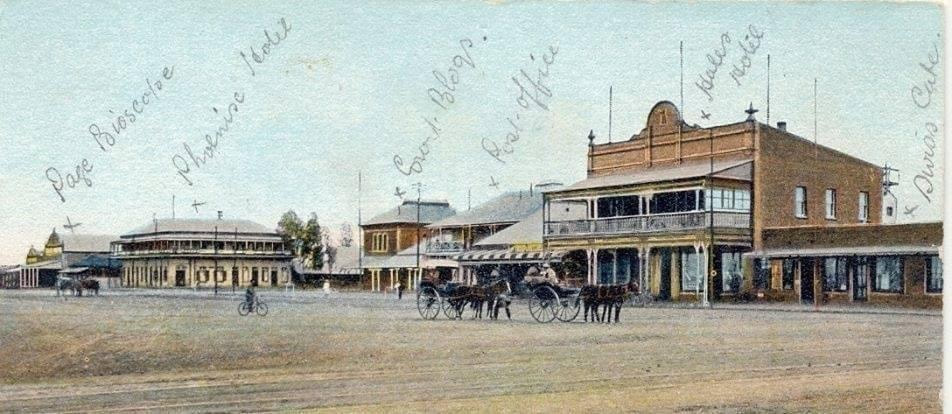Today in Kimberley's History
|
|
|
|
48 days since beginning of the Siege of Kimberley, 1899
Extract from "The Diary of a Doctor's Wife – During the Siege of Kimberley October 1899 to February 1900" by Winifred Heberden.
Jack and I went to the hospital where I saw young Mayston, looking very white and shaky, on the verandah. He said he was trying to kill time, and felt very dull after the late excitement. Captain Rush was also getting on well, though still in bed. A nurse told me that Colonel Scott-Turner's Orderly could not lead his master's horse from the gate for nearly an hour. He quite broke down and leaned on its neck sobbing like a child.
Extract from "The Diary of a Doctor's Wife – During the Siege of Kimberley October 1899 to February 1900" by Winifred Heberden.
Jack and I went to the hospital where I saw young Mayston, looking very white and shaky, on the verandah. He said he was trying to kill time, and felt very dull after the late excitement. Captain Rush was also getting on well, though still in bed. A nurse told me that Colonel Scott-Turner's Orderly could not lead his master's horse from the gate for nearly an hour. He quite broke down and leaned on its neck sobbing like a child.
The town of Beaconsfield is amalgamated with Kimberley - 1912
The last Mayor of Beaconsfield was Thomas Pratley who was in the chair from 1904 until formal amalgamation with Kimberley on 2 December 1912 when Ernest Oppenheimer became the first Mayor of a combined city. The first combined council meeting was on 4 December 1912.
Pratley Street, named after Thomas Pratley, is the street running parallel to Solomon Street, just behind the Solomon Guest House.
The last Mayor of Beaconsfield was Thomas Pratley who was in the chair from 1904 until formal amalgamation with Kimberley on 2 December 1912 when Ernest Oppenheimer became the first Mayor of a combined city. The first combined council meeting was on 4 December 1912.
Pratley Street, named after Thomas Pratley, is the street running parallel to Solomon Street, just behind the Solomon Guest House.
In the early 1880s, and as the Dutoitspan and Bultfontein mining camps began to take on a more permanent look, the inhabitants sent a petition to the Governor of the Cape Colony to change their status to that of a municipality.
The petition was granted and on 16 August 1883 the mining camps officially became known as Beaconsfield, named after Lord Beaconsfield (Benjamin Disraeli), who had died in 1881.
Even the coat-of-arms and motto of Lord Beaconsfield was adopted, the motto being ‘Nothing is difficult to the Brave’.
In October 1883 the Village Management Board was replaced by the Municipal Council, and on 31 October in the Good Templars Hall, Mr Samuel Charles Austen was elected Mayor with Mr C.K. O’Molony as the Town Clerk. Plans were immediately put into action for the laying out of streets, for bringing in water, and for installing a more efficient sanitary system. So lively were the early meetings of the Beaconsfield Council that a policeman was stationed in the council chambers to eject unruly members.
By 1886 the neatly planned township as it is today was in existence while the small villages of Dutoitspan and Bultfontein would be left to die a natural death. Certain of the buildings were in existence between 1883 and 1886 including the Magistrate’s Court (1884), the Phoenix (1885), and St Augustine’s Catholic Church (1883). It does appear from primary sources that the planned township was in existence by 1883, but the buildings were erected over the next few years.
The well-known journalist and writer, Vere Stent, wrote that in 1898 there were 3396 whites, 6650 blacks, and Indians and coloureds totalled 1532, a sum of 10 478 inhabitants. He stated that there were the usual number of tradesmen and civil servants, but that the majority of inhabitants worked as debris workers or on the mines.
“The Beaconsfield Club”, he wrote, “is an institution with a history, and has been transplanted bodily from Dutoitspan village to the main road of this town.” Besides the Club, there were social, dramatic and literary societies. There were not many public amenities, the Public Library being an exception, subscribers paying £1 per annum to be a member. The parish Church of All Saints, wrote Stent, “…is now almost too large for the town, but it is an ornament to the Market Square of which it may be proud.”
The truly magnificent Beaconsfield Town Hall, demolished in 1968, was opened on 11 June 1888 as a memorial to the volunteer military forces of the Diamond Fields who died in the 1878-1879 colonial uprisings. In 1897 a Jubilee wing was added to commemorate Queen Victoria’s Diamond Jubilee while in1902 a clock tower was added to commemorate the coronation of King Edward VII.
That same year – 1888 – saw Barney Barnato being elected in November to the Cape Legislative Assembly as the parliamentarian representing Beaconsfield, a post that would become the long time parliament seat of his cousin many years later – Sir David Harris. The amalgamation of the mines in 1888-1889 saw both Dutoitspan and Bultfontein mines cease production in order to reduce output and the town suffered as a result of massive unemployment. By 1891 the population of Kimberley had halved and in Beaconsfield it had been trimmed by a third. Many miners had gone north to the gold fields.
The last Mayor of Beaconsfield was Thomas Pratley who was in the chair from 1904 until formal amalgamation with Kimberley on 2 December 1912 when Ernest Oppenheimer became the first Mayor of a combined city. The first combined council meeting was on 4 December 1912.
Beaconsfield, often called the Cinderella suburb of Kimberley, is actually the elder sister and should be respected as such.
Historically, apart from the diamond discovery, Rhodes’ Cape to Cairo railroad passed through Beaconsfield before reaching Kimberley in 1885; it was through Beaconsfield that General French rode after relieving the besieged town on 15 February 1900; and it was at the Beaconsfield station that the British soldiers arrived en masse after the relief of Kimberley. Beaconsfield was the rail junction to Bloemfontein once the line had opened in 1908, and it was here that a large marshalling yard was established.
[Text courtesy of Steve Lunderstedt - Facebook page 'Kimberley Calls... and Recalls]
The petition was granted and on 16 August 1883 the mining camps officially became known as Beaconsfield, named after Lord Beaconsfield (Benjamin Disraeli), who had died in 1881.
Even the coat-of-arms and motto of Lord Beaconsfield was adopted, the motto being ‘Nothing is difficult to the Brave’.
In October 1883 the Village Management Board was replaced by the Municipal Council, and on 31 October in the Good Templars Hall, Mr Samuel Charles Austen was elected Mayor with Mr C.K. O’Molony as the Town Clerk. Plans were immediately put into action for the laying out of streets, for bringing in water, and for installing a more efficient sanitary system. So lively were the early meetings of the Beaconsfield Council that a policeman was stationed in the council chambers to eject unruly members.
By 1886 the neatly planned township as it is today was in existence while the small villages of Dutoitspan and Bultfontein would be left to die a natural death. Certain of the buildings were in existence between 1883 and 1886 including the Magistrate’s Court (1884), the Phoenix (1885), and St Augustine’s Catholic Church (1883). It does appear from primary sources that the planned township was in existence by 1883, but the buildings were erected over the next few years.
The well-known journalist and writer, Vere Stent, wrote that in 1898 there were 3396 whites, 6650 blacks, and Indians and coloureds totalled 1532, a sum of 10 478 inhabitants. He stated that there were the usual number of tradesmen and civil servants, but that the majority of inhabitants worked as debris workers or on the mines.
“The Beaconsfield Club”, he wrote, “is an institution with a history, and has been transplanted bodily from Dutoitspan village to the main road of this town.” Besides the Club, there were social, dramatic and literary societies. There were not many public amenities, the Public Library being an exception, subscribers paying £1 per annum to be a member. The parish Church of All Saints, wrote Stent, “…is now almost too large for the town, but it is an ornament to the Market Square of which it may be proud.”
The truly magnificent Beaconsfield Town Hall, demolished in 1968, was opened on 11 June 1888 as a memorial to the volunteer military forces of the Diamond Fields who died in the 1878-1879 colonial uprisings. In 1897 a Jubilee wing was added to commemorate Queen Victoria’s Diamond Jubilee while in1902 a clock tower was added to commemorate the coronation of King Edward VII.
That same year – 1888 – saw Barney Barnato being elected in November to the Cape Legislative Assembly as the parliamentarian representing Beaconsfield, a post that would become the long time parliament seat of his cousin many years later – Sir David Harris. The amalgamation of the mines in 1888-1889 saw both Dutoitspan and Bultfontein mines cease production in order to reduce output and the town suffered as a result of massive unemployment. By 1891 the population of Kimberley had halved and in Beaconsfield it had been trimmed by a third. Many miners had gone north to the gold fields.
The last Mayor of Beaconsfield was Thomas Pratley who was in the chair from 1904 until formal amalgamation with Kimberley on 2 December 1912 when Ernest Oppenheimer became the first Mayor of a combined city. The first combined council meeting was on 4 December 1912.
Beaconsfield, often called the Cinderella suburb of Kimberley, is actually the elder sister and should be respected as such.
Historically, apart from the diamond discovery, Rhodes’ Cape to Cairo railroad passed through Beaconsfield before reaching Kimberley in 1885; it was through Beaconsfield that General French rode after relieving the besieged town on 15 February 1900; and it was at the Beaconsfield station that the British soldiers arrived en masse after the relief of Kimberley. Beaconsfield was the rail junction to Bloemfontein once the line had opened in 1908, and it was here that a large marshalling yard was established.
[Text courtesy of Steve Lunderstedt - Facebook page 'Kimberley Calls... and Recalls]

